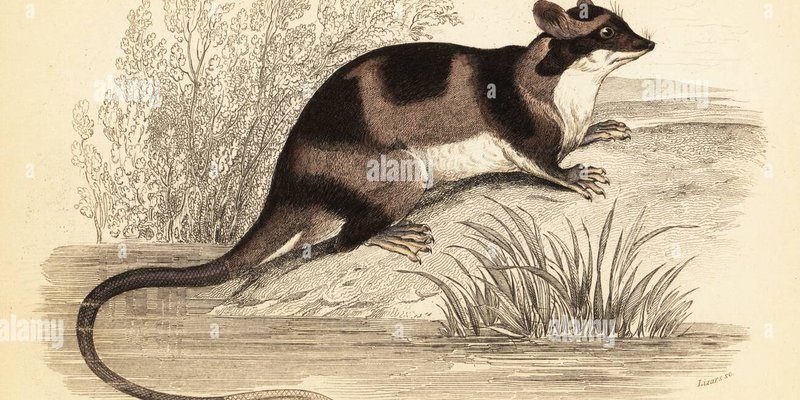![Comparing The Yapok Vs. [Similar Species]](https://gudri.com/wp-content/uploads/2025/06/Comparing_The_Yapok_Vs___Similar_Species__image_0.jpg)
In this article, we’ll dive deep into a side-by-side comparison of these two unconventional animals. Whether you’re an animal lover or just exploring, understanding their differences and similarities can be quite enlightening. So grab a cup of coffee, and let’s explore the captivating lives of the Yapok and the Kinkajou!
What is a Yapok?
The Yapok, also known as the **water opossum**, is a small marsupial native to Central and South America. Unlike most opossums, the Yapok is well adapted to a semi-aquatic lifestyle. Think of it as the adventurous cousin of the classic opossum. Adult Yapoks weigh around 4 to 8 pounds and can be about two feet long, including their tail.
Yapoks have a distinctive appearance with a pointed snout and webbed feet, which help them swim efficiently. Their fur is soft and often grayish-brown, providing excellent camouflage against the murky waters they inhabit. They primarily feed on crustaceans, insects, and small fish, making them skilled hunters in their watery homes. Honestly, observing a Yapok diving for food can be quite a sight—it’s like seeing a little fur-covered swimmer in action!
What is a Kinkajou?
Now, let’s shift our focus to the **Kinkajou**. This nocturnal mammal belongs to the raccoon family and is found in the tropical forests of Central and South America. Kinkajous are known for their round faces and large eyes, which give them a cute, almost cartoon-like appearance. They typically weigh between 5 to 10 pounds and can grow up to two feet long, including their long, prehensile tail.
Kinkajous are often referred to as “honey bears” because they love to feast on fruits and nectar, making them essential pollinators in their ecosystem. Their flexible bodies allow them to climb and maneuver through the treetops with ease. Picture a little acrobatic performer swinging from branch to branch—it’s hard not to smile at their playful antics!
Habitat and Range
Yapoks primarily thrive in wetland habitats like **swamps and riverbanks**. They prefer areas with plentiful water sources, where they can hunt for food during the night. These marsupials are mostly found in regions of the Amazon rainforest and other neighboring tropical areas.
In contrast, Kinkajous favor **tropical rainforests** but are more versatile when it comes to their living conditions. They can adapt to various forest types, from lowland rainforests to montane forests. Their range stretches from southern Mexico through Central America and into the northern parts of South America. While both animals love the lush greenery, their specific habitat choices help them thrive in different ways.
Diet and Feeding Habits
When it comes to food, the Yapok and Kinkajou have very different tastes.
– The **Yapok** enjoys a diet of insects, fish, and even small crustaceans. Their powerful sense of smell helps them locate food underwater, making them skilled hunters. Think of them as little underwater foragers, searching for snacks in the muck. They hunt mostly at night, which gives them a quiet advantage over their prey.
– On the other hand, the **Kinkajou** is a fruit lover! They primarily consume fruits, honey, and nectar, using their long tongue to reach sweet spots in flowers. Their diet is not only tasty but also vital for the rainforest, as they help in pollination and seed dispersal. You might say that they’re like tiny gardeners, promoting growth and sustainability in their habitat.
Behavior and Social Structure
Yapoks are generally solitary creatures. They prefer to roam alone in their territories, marking them with scented secretions. However, during breeding season, they can be a bit more social, forming temporary pair bonds to mate. Their shy and cautious nature makes them less likely to engage with other animals, unless it’s to fend off a threat.
Kinkajous, on the other hand, are more social in nature. They often form small groups, especially when foraging for food. Their playful behavior is evident as they chase each other through the trees, often communicating with soft whistles and grunts. This social structure allows them to bond and share knowledge about food sources, enhancing their survival.
Conservation Status
Both the Yapok and Kinkajou face threats from habitat loss due to deforestation, agriculture, and urbanization.
– The **Yapok** is listed as “Least Concern,” but local populations can suffer from habitat destruction. Protection of wetland areas is crucial for their survival.
– The **Kinkajou** is also classified as “Least Concern,” yet they are affected by similar factors. Conservation efforts focus on preserving their rainforest habitats and mitigating human-wildlife conflict.
By understanding their ecology, we can help protect these incredible creatures and the environments they call home.
Final Thoughts
Comparing the Yapok and the Kinkajou reveals just how diverse and extraordinary our planet’s wildlife is. Each animal is uniquely adapted to its surroundings, showcasing nature’s creativity. The Yapok’s aquatic skills and the Kinkajou’s arboreal agility are just two examples of how species thrive in their specific habitats.
Understanding these differences not only enhances our appreciation for these animals but also highlights the importance of protecting their environments. Both the Yapok and Kinkajou play significant roles in their ecosystems, and by ensuring their survival, we help maintain the delicate balance of nature.
So, the next time you find yourself marveling at the wonders of wildlife, remember the Yapok and the Kinkajou—two incredible creatures that remind us of the beauty and complexity of life on Earth.

